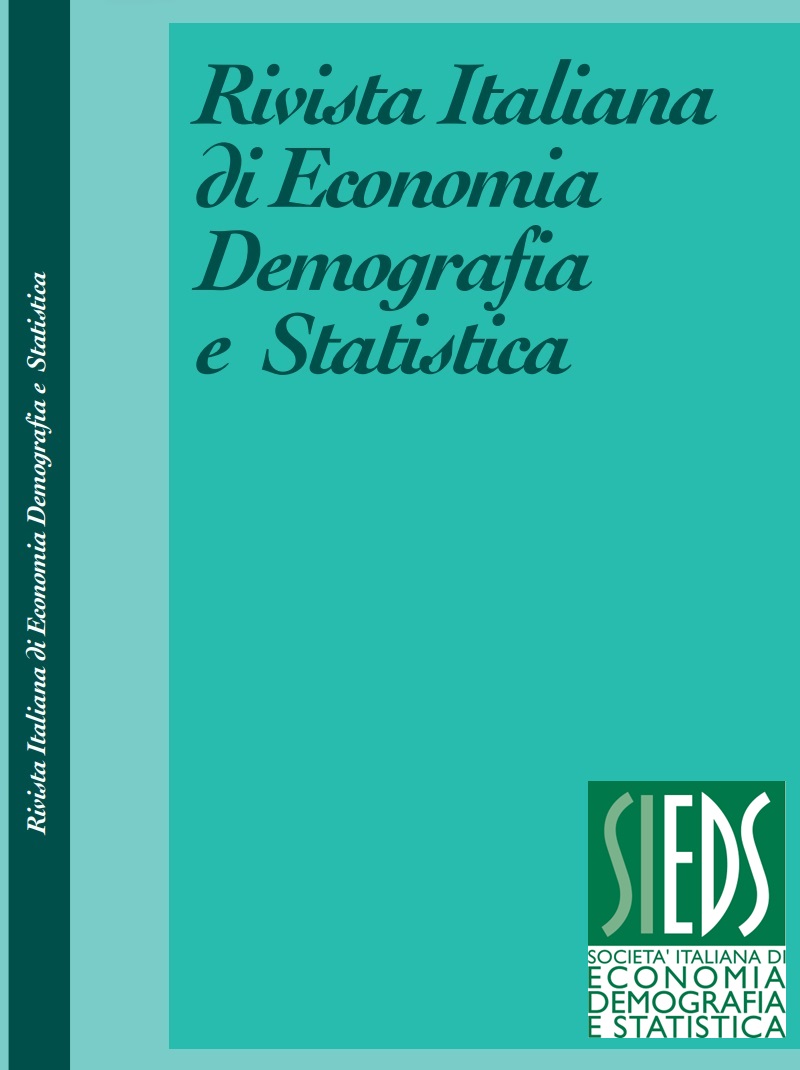Well-being: a Beta-distribution-based approach
DOI:
https://doi.org/10.71014/sieds.v79i4.340Abstract
In recent years, there has been growing attention to evaluating well-being at local level. Along this line, since 2013, the Italian Institute of Statistics (ISTAT) annually releases a dashboard of indicators to measure the so-called Equitable and Sustainable Well-Being (BES) for Italy, its Macro-area (NUTS-1) and regions (NUTS-2). More recently, the ISTAT provides BES indicators at local level (NUTS-3), related the 107 Italian provinces and metropolitan cities.
The aim of the paper is to provide a more in-depth analysis of territorial inequalities and divergences across the Italian provinces. Specifically, the paper represents the first attempt to synthetize the main domain of BES (economic, social and environmental among others) through the parameters underlying the Beta distribution of the multidimensional well-being.
The parameters - mode and concentration- associated with the Beta distribution and used as a proxy of territorial disparities identify a high degree of heterogeneity not only between the Northern and Southern Italian provinces, but also among adjacent provinces.
References
ANDERSON G., PITTAU M. G., ZELLI R. 2014. Poverty Status Probability: A New Approach to Measuring Poverty and the Progress of the Poor, The Journal of Economic Inequality, Vol. 12, pp. 469-488. DOI: https://doi.org/10.1007/s10888-013-9264-5
ATKINSON A.B., BOURGUIGNON F. 1982. The Comparison of Multi-Dimensioned Distributions of Economic Status, The Review of Economic Studies, Vol. 49, No. 2, pp. 183-201. DOI: https://doi.org/10.2307/2297269
BLEYES B. 2012. Beyond GDP: Classifying Alternative Measures for Progress, Social Indicators Research, Vol. 109, No. 3, pp. 355-376. DOI: https://doi.org/10.1007/s11205-011-9906-6
BOOYSEN, F. 2002. An Overview and Evaluation of Composite Indices of Development, Social Indicators Research, Vol. 59, pp. 115-151. DOI: https://doi.org/10.1023/A:1016275505152
CHOTIKAPANICH D., GRIFFITHS W. E., PRASADA RAO D., VALENCIA V. 2012. Global Income Distributions and Inequality, 1993 And 2000: Incorporating Country-Level Inequality Modeled with Beta Distributions, Review of Economics and Statistics, Vol. 94, No. 1, pp. 52-73. DOI: https://doi.org/10.1162/REST_a_00145
DE NICOLÒ S., FERRANTE M. R., PACEI S. 2024. Small Area Estimation of Inequality Measures Using Mixtures of Beta, Journal of the Royal Statistical Society Series A: Statistics in Society, Vol. 187, No. 1, pp. 85-109. DOI: https://doi.org/10.1093/jrsssa/qnad083
GRECO, S., ISHIZAKA A., TASIOU M., TORRISI G. 2019. On the Methodological Framework of Composite Indices: A Review of the Issues of Weighting, Aggregation, and Robustness, Social Indicators Research, Vol. 141, pp. 61-94. DOI: https://doi.org/10.1007/s11205-017-1832-9
HOFFMANN A., GIOVANNINI E., NARDO M., SAISANA M., SALTELLI A., TARANTOLA S. 2008. Handbook on Constructing Composite Indicator: Methodology and Users Guide.
IVALDI E., BONATTI G., SOLIANI R. 2016. The Construction of a Synthetic Index Comparing Multidimensional Well-Being in the European Union, Social Indicators Research, Vol. 125, No. 2, pp. 397-430. DOI: https://doi.org/10.1007/s11205-014-0855-8
KOLM, S.C. 1977. Multidimensional Egalitarianisms, The Quarterly Journal of Economics, pp. 1-13. DOI: https://doi.org/10.2307/1883135
KUC-CZARNECKA M., LO PIANO S., SALTELLI A. 2020 Quantitative Storytelling in the Making of a Composite Indicator, Social Indicators Research, Vol. 149, No. 3, pp. 775-802. DOI: https://doi.org/10.1007/s11205-020-02276-0
MAZZIOTTA M., PARETO A. 2016. On a Generalized Non-Compensatory Composite Index for Measuring Socio-Economic Phenomena, Social Indicators Research, Vol. 127, No. 3, pp. 983-1003. DOI: https://doi.org/10.1007/s11205-015-0998-2
MAZZIOTTA M., PARETO A. 2018. Measuring Well-Being over Time: The Adjusted Mazziotta-Pareto Index versus other Non-Compensatory Indices, Social Indicators Research, Vol. 136, pp. 967-976. DOI: https://doi.org/10.1007/s11205-017-1577-5
NADARAJAH S., KOTZ S. (2007). Multitude of Beta Distributions with Applications, Statistics, Vol. 41, No. 2, pp. 153-179. DOI: https://doi.org/10.1080/02331880701223522
NOLL H.H. 2002. Towards a European System of Social Indicators: Theoretical Framework and System Architecture, Social Indicators Research, Vol.58, No. 1, pp. 47-87. DOI: https://doi.org/10.1023/A:1015775631413
POLINESI G., CIOMMI M., GIGLIARANO C. 2023. Impact of COVID-19 on Elderly Population Well-Being: Evidence from European Countries, Quality & Quantity, pp. 1-23. DOI: https://doi.org/10.1007/s11135-023-01656-1
POLINESI G., MARIANI F., RECCHIONI M.C., RICCIARDO LAMONICA G. 2024. More Than One Story from Composite Indices: A Beta-Bernoulli Approach and Policy Making Decision Scenarios, Mimeo.
SEN A. 1980. Equality of what? In The Tanner lectures on human values. Choice, Welfare and Measurement. Vol.1, Cambridge: Harvard University Press, pp. 197-220.
STIGLITZ J. E., SEN A., FITOUSSI J.P. 2009. Report by the commission on the measurement of economic performance and social progress.
Downloads
Published
Issue
Section
License
Copyright (c) 2025 Gloria Polinesi

This work is licensed under a Creative Commons Attribution 4.0 International License.



